Foreign Insulators
Submitted by Jim and Lis Bergman Anchorage, Alaska Email: majestic@gci.net
Reprinted from "Crown Jewels of the Wire", December 2005, page 18
Verreries de Folembray News:
In April 2003 we returned from a trip to France with a very rare insulator.
The attached photograph shows an insulator with a very different embossing.
This
insulator is a rare Verreries de Folembray CD645 gingerbread mama that is base
embossed "Folembray depose". 112 mm x 76 mm: (4-13/32" x 3
").
For nearly two years we had known that this insulator existed but it
had been elusive on our many trips to France. We found it on an old railway
line. The glass at the base is slightly thicker allowing for the embossing on
the base.
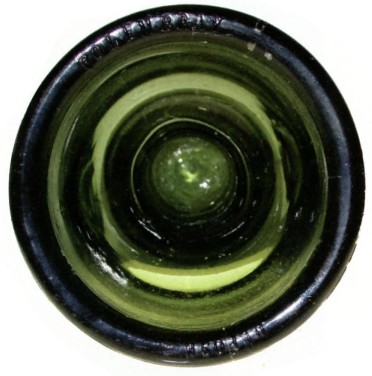
We have done research with the Musee des Arts et Metiers in Paris for
the past several years. This Musee has a small collection of porcelain and
glass insulators that unfortunately are not available for viewing. They have
three (3) of the above mentioned insulators in their collection but in different
sizes than the one we have.
(a) a double skirt gingerbread: height 150 mm x
diameter 97 mm - weight 1,130 kg (5-7/8 " x 3-13/16")
(b) a single
skirt gingerbread: height 150 mm x diameter 95 mm - weight 1,050 kg (5-7/8"
x 3-3/4")
(c) a single skirt gingerbread: height 110 mm x diameter 75 mm - weight 590 g. (4-5/16" x 2-15/16")
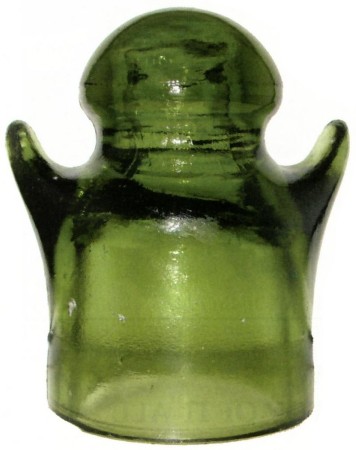
These three insulators were given
to the Musee des Arts et Metiers by an engineer of the "Services
electriques du Chemin de Fer," Monsieur M.E. Sartiaux. The documentation on
these insulators does not show a construction date but the date of entry
received by the Musee is 1900. Therefore there
were factories making glass insulators before 1900. From the 1913 Verreries
de Folembray catalog it is documented that Verreries de Folembray began
manufacturing insulators in 1898. Several insulator manufacturers began making
insulators before their documented date and it is our belief that the Verreries
de Folembray was one of these factories and that the unembossed Verreries de
Folembray and base embossed Folembray depose were some of the first insulators
dating between 1895 and 1898.
All the Verreries de Folembray unembossed
gingerbread insulators that have been found have a single skirt. Again from the
1913 Verreries de Folembray catalog the first numbering system for gingerbreads
was the 100 series all with single skirts followed by the 200 series that all
had double skirts.
Was insulator (a) with double skirt held at the Musee an
experimental insulator?
In June 1978 page 25 of "Insulators-Crown Jewels of the Wire" Jack H. Tod
shows a picture of a French porcelain "pork liver" suspension link
strain insulator of a very early variety owned by Margaret McDermott of Lena,
Ill. This insulator was made by Societe Vedovelli, Priestley et Cie of 160, rue
Saint Charles, Paris, France.
We recently found the same style of "French
pork-liver" strain high up (30 feet) on an old railroad building. But this
strain is in glass. It is in glass made by the Verreries de Folembray and is
embossed "Folembray" and "No. 87". We were able to convince
the "boss" of the station that it was rare. After three days of
negotiations we had this beauty in our hands and the "boss" went away
a little richer.
The No. 87 on this strain indicates that it is a very old
insulator. As far as is known the only other Verreries de Folembray numbers
below 100 that have been found are the old spools that they made. Jack Tod made
reference to U.S. Patent "US1039799 dated October 1, 1912 "Suspension
chain for high pressure electric transmission lines". The inventor of this
patent was Charles Marie Edouard Priestley of France, assignor to Societe
Vedovelli, Priestley et Compagnie of Paris, France.
This Patent was also
registered in Great Britain under patent #GB191027174 on June 1, 1911
(application was filed on 5th April, 1910) and Switzerland #CH55109 dated
November 19, 1910. The France patent and / or a patent for the porcelain and
Folembray #87 may exist but I have been unable to find one. All these patents
state that they are "to improve this suspension chain, in order to make
it more especially suitable for the suspension of high-pressure electric
transmission lines" (lines 27-30 U.S. Patent). The specifications mention
that it could be made in porcelain or glass (line 10 US Patent).
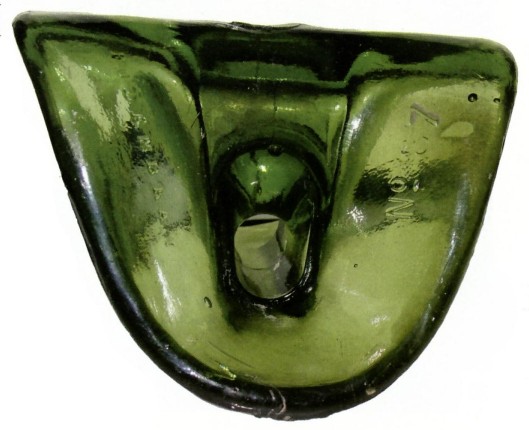
Both the
porcelain strain owned by Margaret McDermott and our Verreries de Folembray #87 look alike
but with more fIared edges than those shown on Patent #US1039799. Verreries de Folembray
made an M3 strain (see photo) that looks more like the patent "US1039799.
The M3 strain is probably a series of strains in different sizes but only the M3
has been found. The M3 that we have is a much lighter green than the
true early Folembray green that #87 is in.
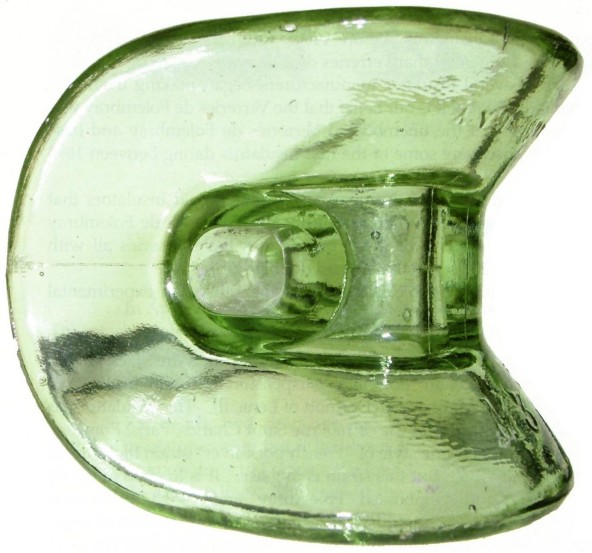
Another incredible recent find is a Verreries
de Folembray No. 603 - "Coupe Circuit pour courant a haute tension".
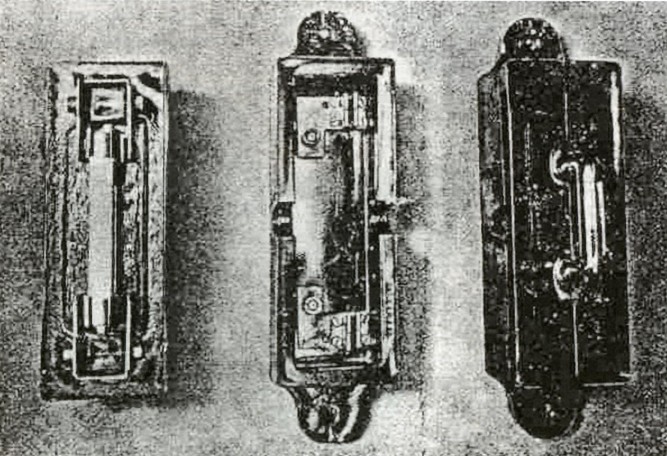
This unusual piece of glass is approximately 10" x 4" x 4"
deep. The thickness of the glass is approximately 15 mm (19/32"). The same thickness as the flanges
on the spooks and robots that Verreries de Folembray made.
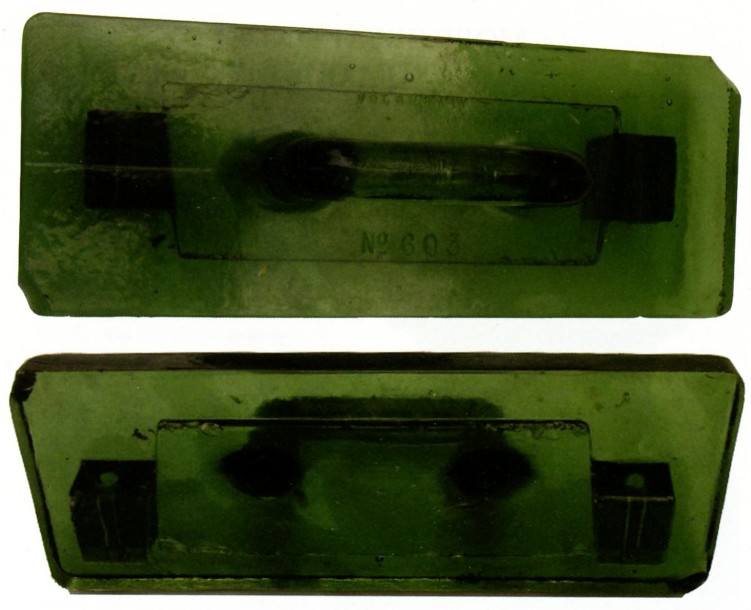
Fragments of a 1913 Verreries de Folembray catalog show this "coupe-circuit"
in 3 sections (see catalog photo). From the photo there are three sections: (a),
(b) and (c). Section (a) is the "working parts" and was either snapped
or bolted to Section (b) Unfortunately section (a) went missing years ago.
Section (b) is the base with a groove on either side of the long sides where the
wires pass through. There are flanges on each short side with a hole for
mounting. Section (c) is the complete unit. The lid is awesome with a glass
handle to aid in lifting off from the base. The 1913 catalog gives a photograph
of No.603 but there is no description. This awesome piece of glass is privately
owned by a friend in France.
Above: Lid with handle, and underside of lid. (c)
Below: Base (b)
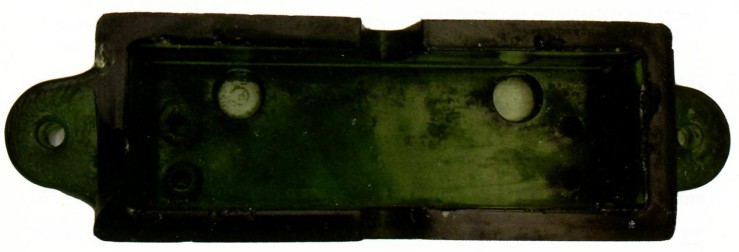
| 